Galápagos
A unique gem in the Pacific Ocean. Experience what it is like to detach from daily life and truly be at one with nature, not found anywhere else on earth....
Discover Galápagos
Discover Galápagos with the best day activities
“Overnight in beautiful hotels on 3 different islands combined with the most beautiful exploration tours”
This versatile holiday allows you you to discover the Galápagos Islands through Island Hopping. You will stay in hotels of your choice (from mid-range to ultimate luxury) on 3 different islands, going from island to island by airplane; quickly and comfortably. Experience the islands like a local, dine at wonderful restaurants and explore nature on excellent day trips.
For a day-to-day overview, click on the program below.


Upon arrival at San Cristóbal airport, you will be welcomed by our local representative and escorted to your hotel in Puerto Baquerizo Moreno. You have the rest of the day at your leisure.
Puerto Baquerizo Moreno is a charming harbour town with just a little more than 6,500 inhabitants. There are several restaurants and it is wonderful to walk along the quay where you will be greeted by various sea birds, iguanas and sea lions.


Today you will set off early after breakfast for your first excursion to Punta Pitt. With your boat, Galápagos guide and fellow passengers you will sail to the eastern coast of San Cristóbal island.
With a wet landing you set foot on the olivine beach of this amazing visitor site. The path runs through a fascinating landscape of eroded tuff formations and provides an impressive view of your surroundings in various places. Punta Pitt is unique because it is the only place where the three types of boobies come together: the blue-footed, nazca and red-footed booby. The latter in particular is special, it can only be found in the extreme north on Genovesa (the largest breeding colony, where they also live together with the Nazca booby) and on a small island near Floreana in the extreme south. In addition to the spectacle of the boobies, you can also enjoy the great and giant frigate birds.
After this walking tour of approximately 2 hours you will have lunch on the boat after which you will visit a wonderful beach nearby. Here you can snorkel or just relax on the beach.
By 5 o’clock in the afternoon you will be back in Baquerizo Moreno.
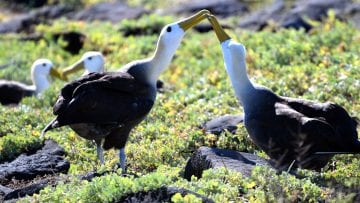

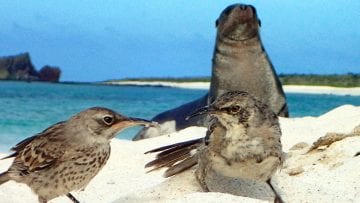

Today you will set off early after breakfast for your second excursion to the island of Española; one of the 3 top islands in the Archipelago with an amazing variety of wildlife and the only breeding colony in the world of the large Waved Albatross.
You will sail south, where you will arrive at Punta Suárez mid-morning. You will land from the zodiac with a dry landing greeted by lazy sea lions. Often you will be forced to step over them to reach the path. You can also come across brightly coloured red and green marine iguanas. As you continue along the path you will look out for the animals that you pass on your way: lava lizards, the Española mockingbird, Darwin finches and the Galápagos dove are frequently found here. With some luck you can also observe the Galápagos hawk.
Further down the path, along the western cliffs of the island, you will pass breeding colonies of blue footed and nazca boobies. swallow-tail gulls and red-billed tropic birds fly to and from their nests and feeding grounds on the rocks. You continue to the south side of the island where the sea crashes violently on the coast. The enormous power comes to life in an impressive blow hole, a natural fountain where the waves blow through the rocks tens of meters high into the air.
The absolute highlight is of course the albatross. In numbers of 25,000 to 30,000, almost the entire world population of adult birds can be found on Española between April and December to mate and breed. The mating dance is a fantastic spectacle to see. The albatross is incapable of ascending itself, so the bird plunges off the cliff to begin its flight catching the wind with its giant wings. (Note, as mentioned, the albatross is not present in January, February, March).
After lunch on the ship you will visit Bahía Gardner. A beach straight from a movie scene. Vast, soft white sand and a turquoise sea. The friendly colony of sea lions on this beach is happy to take a photo with you. And the playful pup might even swim with you in the sea. The Española mockingbird is a fun, cheeky little one. Sit quietly on the beach and notice how they are slowly hopping towards you, closer than you would expect!
Just off the vast beach of Bahía Gardner are Islote Gardner and Tortuga Rock, both very beautiful locations for snorkelling. Tortuga Rock is a large rock formation that sticks out of the water. If you look at the rocks from the right angle, the formation looks like a giant sea turtle that comes to the surface to take a breath. On the side of the rock that is farthest away from the bay, the water is a bit deeper and there is a current. Exactly here you will find spectacular marine life, such as white-tiped reef sharks and manta rays. On the other side of the rocks the water is calmer and shallower, a perfect place for novice snorkellers and certainly no less spectacular. Floating slowly in the water you enjoy the wealth of different fish, including schools of surgeon fish, colourful parrot fish and maybe even a moorish idol. On this side of Tortuga Rock you are also close to the sandy bottom with rocks and small pieces of seaweed. If you are observant, you have the chance to see a scorpion fish. Well camouflaged, these fish wait at the bottom of the ocean until their prey of small fish comes closer. You may also see a stingray resting on the bottom.
After y your boat will return to Puerto Baquerizo Moreno where you will arrive around 5 o’clock in the afternoon.
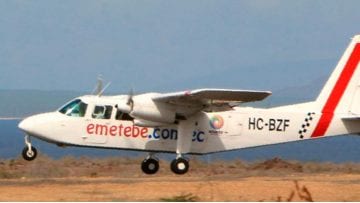

Today you will leave San Cristóbal and fly to Isabela with a small plane. Isabela is the largest island of the archipelago, but only a very small part in the south is inhabited. You spend the night in the small port town of Puerto Villamil, with just over 1,500 inhabitants. You can spend the rest of the day and evening at leisure.


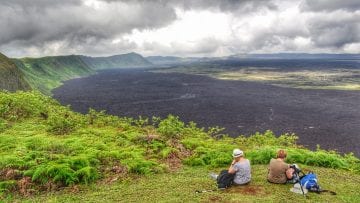

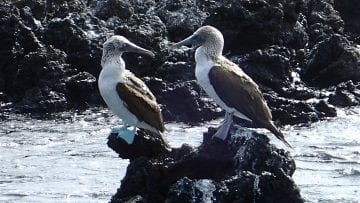



Another early rise ‘n shine for today. A very special tour awaits! On Isabela you will find the second largest volcano crater in the world (the largest is the Ngorongoro in Africa). This morning you will hike this massive natural formation up to the crater rim. In good weather you have an impressive view over the crater (11 km in diameter) and the surrounding landscape. If the weather permits, you will also visit the area of the Chico volcano right next to Sierra Negra. In total this visit takes around 5 hours.
During the tour you will be offered a lunch box after which we will board a boat in the port of Puerto Villamil to sail to Las Tintoreras in about a few minutes. This lava formation, just south of Puerto Villamil, is a beautiful bay to visit. With a panga ride you will explore the the clear, turquoise waters, searching for sea lions, sea turtles, marine iguanas and rays. Las Tintoreras is one of the few places where iguanas can breed in peace because of the absence of natural enemies. After this trip you will go snorkelling. Here you have a very good chance of spotting various sharks; the name Tintoreras is even derived from these residents!
After y you will return to Puerto Villamil by boat.
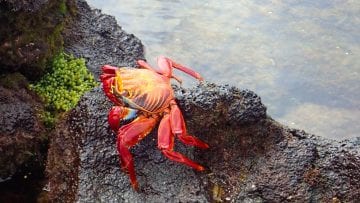

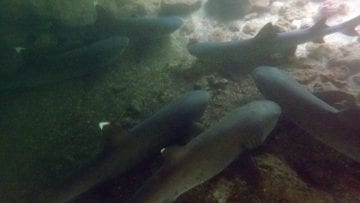

Also today we have an absolute ‘must-do’ destination for you. After breakfast you will depart to the area named Los Tuneles Cabo Rosa, about 1 hour by boat from Puerto Villamil. The lava formations that have shaped these islands look like tunnels and have become a maritime paradise. This uninhabited site is home to, among others, sea turtles, iguanas, sea lions, blue-footed boobies, frigate birds, manta rays and penguins. After a walk through the lava formations you take a dip in the refreshing water. This place is ideal for snorkelling thanks to the crystal clear and shallow water; you will see many different animals and fish.
In the early afternoon the boat takes you back to Puerto Villamil and you have the rest of the day at leisure.






Today you are flying from Isabela to Baltra. Baltra is a small island situated north of the island of Santa Cruz where the airport is located.
Upon arrival at Baltra airport you will be welcomed by our professional guide and your will set off for the town of Puerto Ayora. You board the airport bus to the Itabaca channel to cross from the island of Baltra to the island of Santa Cruz. After the crossing your guide will drive you in a private car through the highlands of Santa Cruz. The highlands are lush and green in contrast to the dry coastal vegetation. The forests in the highlands are dominated by the endemic Scalesia tree and are home to many bird species, including the barn owl. In the highlands you will have lunch at a local ranch and you will most likely see your very first giant tortoises on this island. These beautiful animals are constantly migrating from the highlands to the coast on Santa Cruz.
If time permits, we may also visit one of the area’s lava tunnels and los Gemelos (“the twins”); two giant zinc holes in the landscape, created during volcanic eruptions.
The guide will drive you further to your hotel in Puerto Ayora. Puerto Ayora is the economic and central heart of the archipelago and with more than 12,000 inhabitants also the most populated part of the Galápagos Islands.
In the afternoon you can visit the Charles Darwin Research Station in Puerto Ayora.
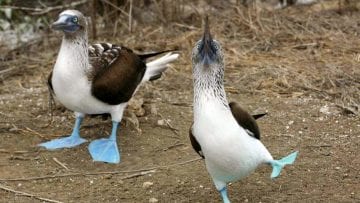





This morning you will be picked up to go by bus with your group and guide to the Itabaca channel. There you board your ship for the day and set sail for the uninhabited island of Seymour Norte
When you approach the island of Seymour Norte it does not seem very impressive at first sight: a small island, low, flat and rocky. But don’t be fooled by perception, the island is a paradise for birdwatchers. Landing on the rocks can be a bit challenging when the seas are rough, but once on land some sleepy sea lions welcome you with reassurance. The path runs along the picturesque coast and then circles inland.
Seymour Norte offers a home to a breeding colony of magnificent frigate birds. The frigate bird is known for its bright red throat pouch. When the male wants to impress a possible partner, he inflates this pouch into a big red balloon and tries to win over the female. The magnificent frigate bird does this year round (in contrast to the great frigate bird) so you have a good chance of observing this spectacle on Seymour Norte. You will often see downy white frigate chicks in one or more of the nests along the path.
In addition to the frigate bird, this island also has the largest population of breeding blue-footed boobies. Where the frigate bird shows off his red pouch, the blue-footed booby performs a nice dance for his partner to show off his blue feet and presents gifts in the form of stones and twigs.
Hold your gaze down while continuing down the path. Not only to ensure that you do not stumble over the boulders, but also because there is a large population of land iguanas on Seymour Norte that are very sheltered by their environment.
After the visit to Seymour Norte you will have lunch on the ship. Depending on availability, you then go to Las Bachas or Islote Mosquera. Both locations have a beautiful beach and are excellent spots to snorkel.
After snorkelling, your boat returns to the Itabaca channel and you take the bus back to Puerto Ayora.


This morning you will be picked up to go by bus with your group and guide to the Itabaca channel. There you board your ship for the day and set sail to the uninhabited island of Bartolomé.
You land at Bartolomé with a dry landing. To protect nature, a beautiful staircase has been constructed that will lead you through the impressive landscape to the most iconic viewpoint of the Galápagos. This small island is in the middle of the archipelago and on a clear day more than ten islands can be seen from the top. It is possible to spot the Galápagos hawk or a heron.
In front of you is Pinnacle Rock, a rock formation formed by an eroded toba cone, the most emblematic formation of the archipelago. At the base of this rock lives a small colony of penguins with sea lions and sea birds.
After a walking tour of about 2 hours on this island you will return to your ship for lunch.
In the afternoon you go snorkelling at Bahía Sullivan. This is a wonderful spot and you have a good chance of seeing penguins in the water.
At the end of the afternoon you return to the Itabaca channel and take the bus back to Puerto Ayora.


Unfortunately today you will say goodbye to “las islas encantadas”. The driver will pick you up at the hotel and take you to the Itabaca channel from where you will take the airport bus to Baltra airport for your flight to either Quito or Guayaquil.
This voyage combines one of the best possible itineraries with by far the most elegant ship in the Galápagos Islands. You visit spectacular locations aboard a historic yacht; a journey that touches the soul.
Go back in time aboard an iconic barquentine and visit the ages of pirates and whalers. Discover the Galápagos in all its facets: animal life, fauna, volcanic landscapes and human history. This 360° perspective of the Galápagos Archipelago will make your stay impressive and comprehensive.
A somewhat smaller ship, a somewhat shorter itinerary. Adventurous with great visitor sites! During this trip you will visit some of the best snorkelling areas in the Archipelago.